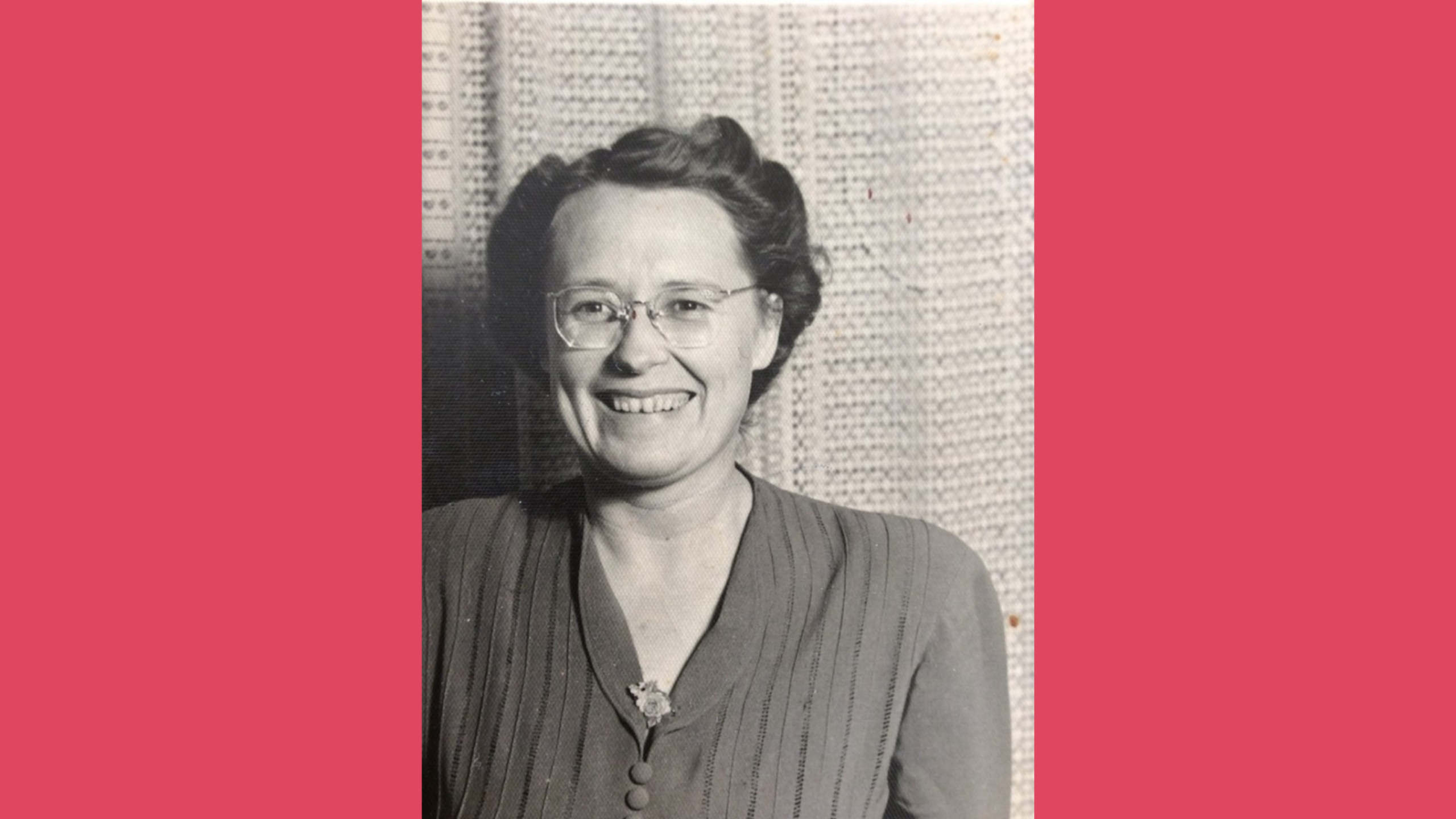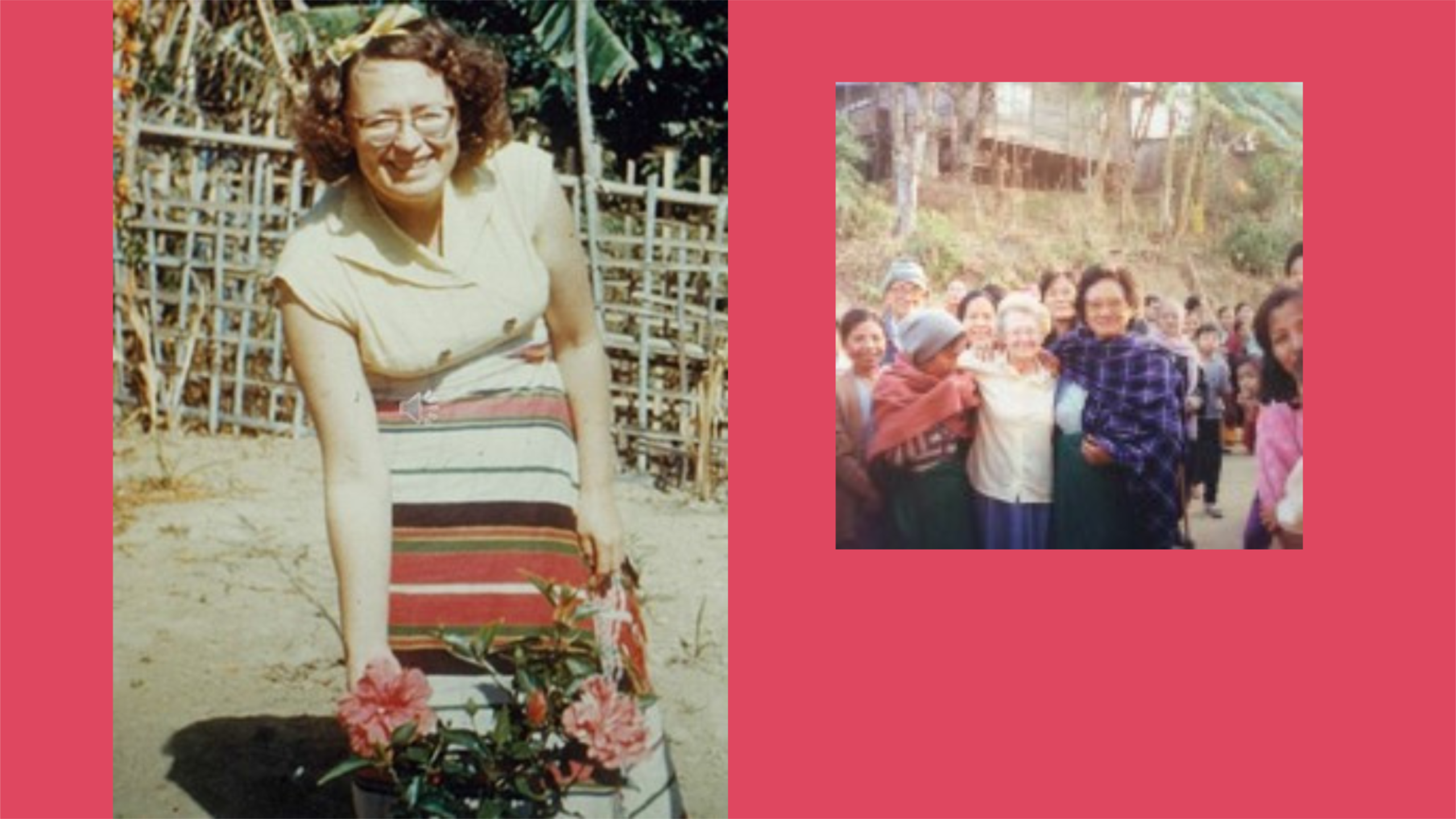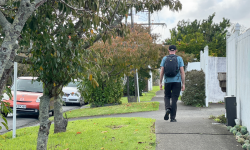
Woman of the month is a column provided by Baptist Women New Zealand. More articles, resources and event information can be found at women.baptist.nz
Marjorie Turner carried out pioneering mission work in East Pakistan and Tripura during and after World War I, the first woman to manage alone a mission outpost. After only 14 years, she was required to nurse her mother in NZ. Then for 20 years, she wrote and provided in the Mizo language Bible study commentaries for village churches in North Tripura, NE India.
Author, Mary Tallon, is the niece of Marjorie Turner. She acknowledges editorial contribution from Beulah Wood and Elizabeth Jones.
Early Life
Marjorie Ethel Turner, fondly remembered as Marnie, was born in Ponsonby, Auckland, 17 September 1918 during World War 1. She had warm memories of living at ‘The Rocks’ on New North Road, a villa built by her mother’s father James Penman who also built Mt Albert Baptist, Mt Eden Baptist, The Tabernacle, Rendells and many kauri villas around Auckland. Her grandfather was a great raconteur, a trait inherited by his daughter May Thompson, Marnie and her oldest brother, Jack.
Faith in action was central to the extended family’s life. Marnie recalled Saturdays getting ready for church and preparing lunch for family and visitors as Sunday was ‘a day of rest’. On Sunday morning, the children walked to junior Christian Endeavour and a service at Mt Albert Baptist, returned to lunch then walked the mile back to Sunday school where father Harvey Turner was superintendent and mother Ethel a teacher. Mt Albert was a young suburb, ripe with families interested in hearing the gospel. The Sunday School numbered hundreds. Later in the day, the family would return to Bible class, regular outdoor crusades on New North Road, prayer meetings, evening church, supper, with Ropeholders[1] squeezed in once a month. Little wonder that Marnie was too exhausted to sleep on Sunday nights!
Through a visit to the Bible Training Institute as a young teenager, Marnie felt God’s call to missionary work in India. She trained then worked as a speech and drama teacher.
When World War II broke out, New Zealand Baptist Missionary Society decided to send no new staff, so Marnie relished two years at Bible Training Institute, particularly the lectures of JO Sanders and Mr Yolland and the camaraderie of student life. NZBMS then advised Marnie to train as a nurse, so at 25 she began training at Auckland Hospital. She had only done a year’s training when called by NZBMS to India in 1944. Then, because of the War, Marnie waited for seven months in Australia, before eventually travelling to India by ship through dangerous waters peppered with submarines.
Initial Mission Work in Bengal and Tripura
When Marjorie arrived in Kolkata, no one could meet her for several days because of a Field Council Conference. Kolkata was teeming with soldiers and extremely orderly, but Marnie was shocked by the yawning gap between rich and poor. Miss Bradshaw finally met her but Marnie had developed dengue fever and was now very ill. When they arrived in Brahmanbaria, she was carried into the mission school on a stretcher and remembered girls lining the footpath singing, “Glahd to see you, glahd to see you, berry berry glahd.”
Marnie spent 1945 in Brahmanbaria learning the Bengali language, working in an orphanage, and helping in tent missions. The following year she worked in Chandpur with Eileen Coad and Doris Adams. India was pushing for independence from Britain and after this was divided into India and West and East Pakistan. Partition took a deep toll on life and property. Anti-European feeling was high. People harangued her, calling out “Pink monkey go home!” Children threw stones and shook swing bridges as Europeans tried to cross. Some missionaries were shot, and it was a frightening time for everyone. There was much bloodshed from the internal Muslim/Hindu conflict and putting Christian crosses on the doors helped many to remain safe.
Marnie recalled Gandhi visiting the area and holding a prayer meeting. Thousands flocked to it and when she was encouraged by a visiting American to accompany him to the event, which promised to be historic, she asked the houseboy to guard the property. Later, however, she looked across the crowded meeting and saw her houseboy sitting absorbed by the gravidas of the occasion without a thought for the task he had been given.
The mission in Tripura, begun in 1930s after many years of seeking permission from the Maharajah who eventually relented, was still young. A small boarding school and hospital had started and small Bible study groups and churches. When Marnie arrived, the population of Tripura consisted of 547,000 Hindus, 123,000 Muslims, 30,000 Buddhists, and 274,000 animists. Many of the animists were from the hill tribes and Christians were still few.
After working in Tripura as a teacher, Marjorie was invited late in 1949 to join Dr Nola Ivory for a few months visiting villages in the jungle at the foot of Jampui Range, North Tripura among Buddhist Chakma tribals. This involved a great deal of trekking, gathering leeches en route for use in bloodletting, holding clinics in every village and after long, gruelling days being invited to speak at evening prayer meetings. Living in a one-roomed bamboo hut with Dr Nola Ivory, she gathered a little about tropical medicine.
She had many stories about working in Kanchanpur. She remembered elephants shaking the flimsy makeshift hospital where both they and their patients were sleeping. She recalled the contrast between a Christian and a Hindu death. Hindus would beat themselves and wail as their relations faced death, lacking hope about the outcome.
The Work of Marjorie’s Heart’s Desire
In Kanchanpur Marnie had a Macedonian call to the Jampui hills. Lalkhawthangi (most often called Thangi), a girl brought to the mission hospital with a heart problem, told Marnie that though the men in her hill village had become Christians, they kept their cultural superiority towards the women and did not share their faith or the Bible with them. Marnie accepted the challenge and sought permission to begin a new work in Jampui. She would be the first white missionary woman living alone in an isolated village. Some NZBMS men were unhappy about this venture into such remote territory that still bore the stamp of headhunters.
People commented that Marnie was hilariously funny and made the best of any situation. In this case, she was amazingly patient with NZBMS and did have support from Rev Harry Jones and Royston Brown when it mattered. They encouraged her to follow her calling. The hill country was undeveloped with no roads or modern transport. Crossing deep rivers carrying packs and travelling in small crafts negotiating swollen rivers would be the norm, living three days away from other Europeans.
Marjorie took her first furlough, and then, with Thangi, travelled through the Lushai Hills area to Jampui in 1948. Lalkhawthangi grieved that many there were merely carried along by the enthusiasm of others. Further, that the second generation of Christians did not practise Christianity as she knew it, especially the women—just chattels to the men, with no time or encouragement to learn about Christ for themselves, and always toiling at carrying water from the (inadequate) water holes before and after work on the steep hill-rice fields, and weaving at night. The men thought that so long as they knew the right way, it did not matter whether the women knew or not, and they had made up a set of so-called Christian laws which were far from the Law of Love. They needed help and village elders reluctantly allowed her to work among the women for a trial period.
Marnie learned the language through the Mizo New Testament1, took women’s and children’s meetings and distributed medicines as Dr Ivory’s representative in the area. She enjoyed the same sort of bamboo house as villagers. Bears sniffled around eating mandarins from the trees and king cobras could be seen and sometimes the sound of padding leopards. Marnie was happy—walking far and buying local food—rice, maize, pumpkins, pumpkin leaves, mandarins, occasionally chicken or egg.
There was only one pastor for several villages, so Marnie was expected to preach. She drew up the outlines, found someone to help translate, and spoke with some diffidence because of the tonal language. People assumed she was almost a doctor and came from far and near for medicines and treatments. Mission compounder, Lianthanga, had also come to the Jampui Range, and he was always a tower of strength.
Since Marnie taught school, the Indian government placed her on a blacklist. An official from Delhi investigated her activities. A couple of years later another official investigated after the elders got her to establish a Junior High School. He arranged for a new school in the adjacent village in competition. That was okay. It brought free education.
Then, because Marjorie was giving out medicines, the first official set up a hospital in the village and sent a Bengali doctor to run it. However, when the doctor compromised a village girl, angry Mizo people surrounded his hut and called through bamboo pipes, ‘Go home Dr Bar, Go home Dr Bar.’ As the Mizos were known as headhunters, the doctor left in great haste. The school and the hospital were intended as government ventures to raise its popularity with the people. Both were to be staffed by government employees but ironically, the positions were filled by Mizo Christians and became part of the mission work. Marnie believed this was God’s overruling.
She introduced All-Age Sunday School with exams, bought a shield, and organized village competitions each year. She started Young People’s meetings in every village, and conventions for the Mizo women. They were delighted.
Marnie told of God’s protection, ‘almost too wonderful to tell’, she felt. ‘One night I dreamed that two poisonous snakes were in my house. I saw them distinctly, one in the medicine cupboard, one under the bed. In the morning, I told my henchman, Hawia, of the dream, and later I was a little astonished to see him sharpening a stick. “To kill the snakes,” he said with a grin. A little later, he came to me with an ashen face. “I’ve just killed the first snake in the medicine cupboard,” he said. Sure enough, there was another under the bed. But for that dream we should never have looked for them.’

Long-lasting Literature Work
At the end of the trial period, in 1955, Marjorie wrote to NZBMS asking for permission to stay and the Mizo people warmly endorsed it. Then, when news came that the Old Testament was being translated into Bengali, it was clear this would be used in Jampui, for Bengali was widely spoken in Tripura by then. Marjorie’s work changed. With the help of a keen young man named Hnehliana and using her old Bible college material, she began to write notes on the Old Testament for the villagers.
When her mother became very ill in Auckland, Marnie was required to nurse her. Although her heart was still in Jampui, she took comfort in knowing that Mizo Christians like Hnehliana and other outstanding nationals could continue the work. The notes on the Old Testament were completed and Marnie returned to New Zealand in 1958 with Lalkhawthangi who had been told she could never marry because of her heart condition. She saw a New Zealand heart specialist who said the scar tissue would heal and that she could marry. Very soon after this news, Thangi received a proposal in the mail from Hnehliana.
For twenty years following Marnie’s return to New Zealand, she sent weekly duplicated Bible studies in Mizo to people in twenty villages. The people said when she finally visited, ‘We have kept all your lessons. After you left, you did far more for us than when you were here, because here you could help only one village at a time, but now you can help us all.’
Based back in Auckland
Captain Dovey and his wife had been keen supporters of Marnie’s work and loved the Mizo people, sending regular parcels, as did her family, friends, and members of Baptist churches all over New Zealand. Marnie married Captain Bill Dovey in 1982. Her husband lived only six months after their wedding as he suffered a stroke a week before their marriage. Marnie looked after her father and her husband with the help of her sister Audrey, several nieces, and their husbands.
On several occasions, Marnie tried to visit the Mizo people and in 1966 returned with her friend Beth Roper. However, all other attempts failed until 1994, after more than 35 years had passed, when at last God opened the way for her to return for the Centennial Celebrations of the churches in neighbouring Mizoram held in Tripura.
She was accompanied by Win Penman, her cousin who had spent time with her in Jampui; Elizabeth Jones who with her husband Gordon had spent a wonderfully fruitful 15 years working in North Tripura and then in Agartala; and Jim Skett the NZBMS Secretary. It was the first official visit by NZ Baptists in 20 years and the joy of seeing the expansion of the work was a highlight of Marnie’s life.
Her commitment and dedication to the Mizo people continued to her death when she was still singing in Mizo, ‘Yes, Jesus loves me, the Bible tell us so.’ Marnie died in 2013 surrounded by three nieces. She had been a loving aunt who lived humbly with a clear understanding of the essentials of life’s pilgrimage. A wordsmith, who played a superb game of scrabble, Marnie had a great command of language and knowledge of literature. Her diaries of her time in India are self-deprecating and observant, laced with wry humour and starkly honest.
Young at heart, Marnie travelled light, unburdened by the trivia that so often clutters modern life. She loved and prayed faithfully for her family; she loved and laughed with Captain Dovey and his family; she loved and prayed for her Mizo family and was a true disciple of Jesus. She was her own person, not swayed by the opinion of others but quietly resolute about what she held dear.
Her decision to move into a residential home by the age of 80, along with a decision to give away most of her possessions, was an example to us all. She learned from experience not to impose that burden on those she left behind. ‘We brought nothing into this world…’ When asked what she would do without her beloved books she replied, ‘All the classics are here in the library. I’m going to start at the beginning and work my way through.’
The Jampui villagers who won her heart called her ‘Pi Zoduhi’, which translates as ‘lover of the people’. They saw the true essence of their teacher, a woman whose soul was pure, whose passion for prayer allowed God to intervene and effect change in remarkable ways. She was an inspiration to the end. Her knowledge of the Bible was profound. She was a winsome advocate of the love of Jesus to each person she met. Marnie was one of the great cloud of witnesses who have posted clear signposts along the way for those following behind.
Sources
Interview Marjorie (Dovey) Turner, Kay Gillies, 1991
Oral History Interview Marjorie Turner (Dovey), M E Tallon, 1995
Obituary, M E Tallon, 2013
NZBMS material Delsie Guy, interviewed M E Tallon 2015
Edgar, SL and MJ Eade, Toward the Sunrise, The Centenary History of the New Zealand Baptist Missionary Society, New Zealand Baptist Historical Society, 1995, Auckland, Pp 230-237
[1] Children’s and youth mission movement


